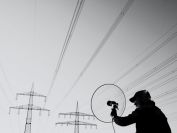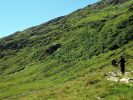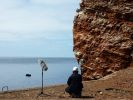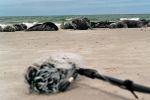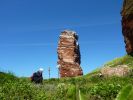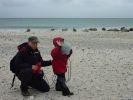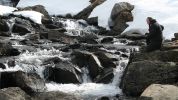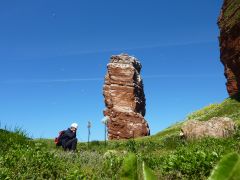Lasse-Marc Riek was invited for this interview by Tobias Fisher and Lara C.Cory, the editors of the music website music Fifteen Questions. "The serie does not cover private lifes, latest releases or questions of taste, but rather deals with music: How it is made? What are its limits? What is the creative process? Why does it affect us all so differently, yet remain universal?"...Fifteen Questions seeks the involvement of experts, scientists, performers and composers to discuss what music means."
Riek’s activities run the gamut, beginning with his own sound work and music, but especially to his activities behind the German publishing house _Guenrekorder, which, aside from dozens of album releases, also spreads ideas about the importance of acoustic ecology and bioacoustics across Europe and beyond. Since 2008 Riek, together with Daniel Knef, also publishes the free bilingual pdf magazine Field Notes, which is concerned with the "phenomenon of sound from the most varied perspectives: artists, musicians, journalists and scientists contribute their essays, interviews, travelogues, anecdotes, notes and images".
Fifteen Questions: When did you start recording in the field — and what or who were your early passions and influences? What what is about music and/or sound that drew you to it?
Lasse-Marc Reik: As a child I came to conscious hearing by some coincidence or fate. From that moment on, the passion of listening to the world and listening within myself grew steadily.
When I first got access to mobile recording technology around 1996, I started the practice of collecting noise. By consciously listening to the recording situations and the sounds themselves, the first ideas for an image and the respective formats were already coming up. Through my own experience, the task of encouraging holistic listening and eavesdropping on society has grown. Therefore it is not only about the aesthetic moment but also about the activism.
We played “house music” as a family. I think it came from my grandpa, who was a great improviser. Each player got an instrument and started playing. I think it was the very first introduction to listening to others, to rhythm, timing, etc.
From the mid-80s to the mid-90s we lived in a house near a forest in the north of Germany. It was part of our normal everyday life to walk and play in the forest. From year to year we found many beautiful places. You had to listen to the surroundings to navigate through them, especially if you didn’t follow the paths. During this time I learned as a child to listen to the messages of the forest and what they meant.
Between the ages of 13 and 15, I started going into the forest more and more often, alone and later and later at night, because I liked to listen in the dark. Each sound was so incredibly distinct and different.
You cannot imagine how many sounds there were! They came from insects, bigger animals, birds, wild boar, deer, small snakes and from wind, heat and cold. I think that in these years I learned a lot about hearing in nature and I made the decision to be a part of it all.
Since the age of 17 I have been intensively engaged in the visual arts. It became my way of life and a way for me to understand the world. I also learned several professions before I started my studies in Frankfurt am Main around 1999, when I moved there from the north of Germany. My career developed as a freelance visual artist spanning several disciplines — finally I decided that working with sound was what interested me most.
For most artists, originality is first preceded by a phase of learning and, often, emulating others. What was this like for you? How would you describe your own development as an artist and the transition towards your own voice? What is the the relationship between copying, learning and your own creativity?
In my childhood and youth, the diversity of music has always played an important role. I remember my father and listening to Kraftwerk’s “We Are the Robots” in the darkened living room on the floor. There was always a lot of music playing at home. Psychedelic and rock were staples. In the music of Pink Floyd I heard the frogs/insects between songs at some point … I think that was my introduction to the use of ambient sounds in music. Nature sound then became a kind of music style for me. I also discovered conceptual work with sounds. Musique concrète.
I found working with sounds exciting. I began to compose a kind of soundtrack with sounds. Collages! That was still strongly influenced by psychedelics. I discovered Walter Tilgner’s seasonal recordings at the flea market … then Bernie Krause and Co. Through the Touch label, I finally found a younger field recording scene and listened to Chris Watson’s recordings. Then the field opened up more and more. I started recording from where I lived, continuing beyond the village and town boundaries to the near-natural areas. More and more uncut recordings were made, which for me had a unique selling point. Between the experiences of the different approaches I found more and more my own interests. A connection to the world through sound and being.
What were your main challenges when you started out recording in the field and how have they changed over time?
In nature and animal phonography, the elements are, e.g., wind, rain, temperature, humidity and a situation which can hardly be controlled. This has not really changed. With every shot there are new and old challenges…
What was your first set-up like? How and for what reasons has your set-up evolved over the years and what are currently some of the most important pieces of gear for you?
A borrowed mini disk recorder and a small external stereo microphone. This was quite sufficient at the time. Handy and easy to use. To capture different perspectives, you need the respective devices. This was always dependent on the recording location and the situations to be recorded.
For quite a while I recorded various bat species. The locating signals are in the ultrasonic range, so I needed an appropriate device, in this case, an ultrasonic detector. In the inaudible range, for example underwater, I needed a hydrophone. For atmospheres I needed multi-channel possibilities, a parabolic mirror for remote recordings, etc. I am currently interested in the signals of plants and insects. For this I rather need sensors and conversion systems.
How do you make use of technology? In terms of the feedback mechanism between technology and creativity, what do humans excel at, what do machines excel at?
The human hears, the machine works.
For me, there are actually always only individual solutions on the spot. For a tunnel system, for example, I had extended the stereo and provided the inputs and outputs of the tunnels with a microphone each. Of course this is not a real stereo anymore, but maybe the one from the tunnel itself.
For a while I buried microphones and also recorders in recording mode, of course with a marker so that I could find them again. Often I put the smaller recorders into objects. These were then transported or stored. I found the perspective exciting … In trees I hung small, many microphones in the branches or from the branches of a tree. How do you hear the fruits of the tree?
Production tools, from instruments to complex software environments, contribute to the compositional process. How does this manifest itself in your work? Can you describe the co-authorship between yourself and your tools?
I use relatively few complex software environments. The composition and the ideas are often in the situation, in the moment. It then only takes a few steps to bring the whole thing into a time. In the last 100 years we have designed a lot of new devices to understand and listen to the world of sounds and their causes. After practice and experience I have the feeling that we could just as well go back to direct, unamplified hearing above us, the body, the ears. Just then we have the possibility to develop our sense of hearing. Maybe not to develop it further at all, but simply to “just” use it.
Collaborations can take on many forms. What role do they play in your approach and what are your preferred ways of engaging with other creatives through, for example, file sharing or just talking about ideas?
For me, cooperation with colleagues is playing an increasingly important role. In most cases, it is also long-term projects that deepen such cooperation.
Since 2004 I have been deleting recordings with Christoph Korn for our project Series Invisible. Here, the focus is on dialogical work. We inform each other about the recordings we have just deleted with a message. Like a kind of correspondence. The result is an archive with deletion notes and processes that can be found in different formats. With Thomas Siefert I deal with the essence of “river” at irregular times, in this case the Rhine. And I have been doing this for 13 years now. We meet at a point on the foot and walk and listen to it for a whole time, sometimes for days. We then live together on and in the river, so to speak. During the breaks we deal with the impressions and exchange our very personal impressions. Thomas then feels and thinks about the stone and the story and I, for example, about the sound. These kinds of cooperation are very important for me.
Could you take us through a day in your life, from a possible morning routine through to your work? Do you have a fixed schedule? How do music and other aspects of your life feed back into each other — do you separate them or instead try to make them blend seamlessly?
For me everyday situations are connected with the respective projects. The concepts and ideas usually arise during hikes and time out. Shooting happens less spontaneously. I often try to integrate the private into actions. Of course, this does not always work. When my children are with me, I usually work on the routine processes in the studio.
Viewing, listening, editing and sorting. When there is air in the evening again, then it’s off to compositional work, whatever that means.
Could you describe your creative process on the basis of a recording or album that’s particularly dear to you, please? Where did the ideas come from, how were they transformed in your mind, what did you start with and how do you refine these beginnings into the finished work of art?
All the works that I have published are close to my heart. It is a matter of the heart for me.
If I now spontaneously pull one out of my heart, there is a tree in Finland in front of me. This tree stood in front of the kitchen window of a residency in Alarjarvi, Central Finland. Outside, extreme early summer storms were raging and I watched this tree dance every morning. Of course there were many more trees. Quite a lot, of course. A round dance. Since I lived in the forest, so to speak, I decided to take the opportunity to make an acoustic portrait of this tree, these trees. Trees have very different meanings in different cultures. For me they have always been companions, since the first moment I became aware of them as a little boy. The rooting and the stretching of the branches, the connection with the sun, the soil and the seasons, the interconnectedness under the earth with other trees of its kind. All this was and is close to me.
So close that I wanted and still want to approach it acoustically. So I started early to record the small still young leaves in the wind. Since I would be on the spot for a longer time, I had the idea to record the process of growing leaves acoustically. Furthermore I was interested in the tree as a body. So I examined it with a stethoscope to listen to the sap extraction. In a storm this and every tree has its own sphere of sound due to the architecture, structure and density of the branches, the location and the wind force. I recorded these conditions for hours a day.
I fixed the contact microphones close to the outer bark with plasticine. I stowed the recorder in a backpack on the ground. I did this for days on end. After a few weeks of daily accompaniment, I created a material that concentrated on the inner life of the tree and the outer signals of the crown. I decided to shorten the shots and not to edit them decisively, sorted them by trunk and crown of the tree and intuitively searched for the highlights. Thus a conceptual album about the inside and outside was created. At the time I sent it to Dale Lloyd in the USA and after some time I got an answer. We worked on the album and it was released with the title: One Hour As Trees In Finland in 2016 on his label and/OAR.
Later I went back to the place at other times of the year and started recording at minus 20 degrees and colder. Under such temperatures the trees crack especially. The fibers seem to react under this cold.
Even the infestation of pests can be brought into the audible range with the right sensors and contact microphones and thus indicate the change of habitat and environment.
Today I start to examine different trees in the ultrasonic range. For a few years the different possibilities to record the situations and circumstances of the trees in different ways are more and more discussed. For example, the dry seasons and their effects. So it develops further and further. Like the growth and decay of such a tree. So in this case one could speak of an open project, in which formats are created again and again, which try to present the essence of the tree in different ways. An open work of art, if you like …
There are many descriptions of the ideal state of mind for being creative. What is it like for you? What supports this ideal state of mind and what are istractions? Are there strategies to enter into this state more easily?
I would say that when we come in an ideal state of mind, nothing can distract us. For example, I can concentrate well when I’m distracted. When there are movements and reactions from all directions, I often become quite calm, concentrate on the essential. Before I start drifting off into thought states again, I quickly leave the studio and sweep the yard for a while or sit down in the shade of the hazelnut trees. So I do something completely different. The transformation of the aggregate state.
If I can manage it, then I take a lot of little breaks. So on the one hand I can concentrate very well while working and on the other hand this energy of the omnipresent is in the doing.
How is recording in the field and editing the music in the studio connected? What do you achieve and draw from each experience personally? How do you see the relationship between improvisation and composition in this regard?
The places and their attentions are connected through me with memory and expectation. The experience of the place is very decisive for me. It helps to access the material in a new and often different way in the studio.
The material speaks to you when you listen. From within yourself. That is something completely different in the studio compared to the recording process in the field. Both forces, the energy in the field and the one with spatial and emotional distance in the studio often form a connection. In areas of sound recording in the field, I often start from a composition. The planning, the realization are in relation to what is supposed to happen in the field and finally happens. When situations change, which they almost always do, then I’ll use improvisation. The first take of the recordings is changed or even broken off. This process is transferred with the material into the next state. Often another mixture of impro and concept.
I think it has to do with the openness and unity of the situations. If we give ourselves completely to change, we can improvise with the composition.
How do you see the relationship between the ‘sound’ aspects of music and the ‘composition’ aspects? How do you work with sound and timbre to meet certain production ideas and in which way can certain sounds already take on compositional qualities?
I personally try to work without categorising sounds into noise and music. Our perception of them is in constant change through the open ear of the recipient. The material speaks holistically and the more we preserve this wholeness, the more it gives us the power to keep the quality on the surface. This makes it easier for others to hear.
Our sense of hearing shares intriguing connections to other senses. From your experience, what are some of the most inspiring overlaps between different senses — and what do they tell us about the way our senses work? What happens to sound at its outermost borders?
Especially when working in the field, almost all, or better, even all senses play a decisive role. We are in the here and now and drive up the perception with all senses. Of course you can practice this or practice yourself, if there are such situations.
In addition to the acoustics, shapes, movement and scent play a major role. We cannot record everything with the microphones. Therefore we should continue to rely on our ears. So I take off the headphones more often. Move away, come back, lie down, sit … Temperature, humidity and e.g. air pressure, all these conditions give us information about the situation, bring us even closer to the now.
Art can be a purpose in its own right, but it can also directly feed back into everyday life, take on a social and political role and lead to more engagement. Can you describe your approach to art and being an artist?
For me, art or the kind of art in which I move is a form of being in oneself, connecting with the outside world, being part of the world. Depending on the receiving station, the art of sound, especially the handling of environmental sounds, can take on and/or assume social and political roles.
I see the actual task as an invitation to the recipients to become a part of things themselves. To remember, to move. To move something. I believe in dialogue through art. The art of dialogue. To create a magic, an interest, an ear note. To the world. Because all we really need is a place in this world. We are part of it. Therefore, we should connect and take responsibility. The responsibility to respect and preserve the world in our own few small environment. As artists we can be emphatic and generate empathy. Empathy with the isteners creates the emotions needed to regain access to the world. Then we can also be a part of it and become active.
It is remarkable, in a way, that we have arrived in the 21st century with the basic concept of music still intact. Do you have a vision of music, an idea of what music could be beyond its current form?
Perhaps when music is no longer just a tool, but becomes part of your life. To resonate with every movement, every attitude, every opinion. Swing. A communication of vibrations, which could be dissonant and harmonious to equal. Good and bad cancelling out. To feel time not as something running, disappearing, but as a moment. Like, for example, the moment in which we love, are in love. Time is suspended. Another time is experienced. There could be only love left until dissolution.
